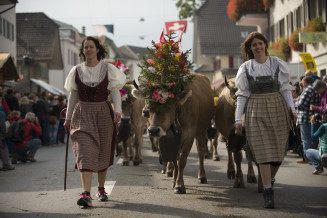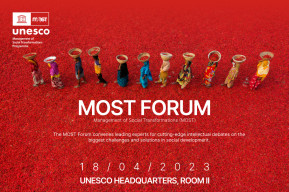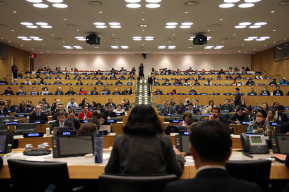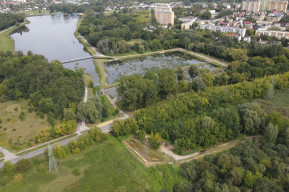Article
Carolina Adler: Bridging science and policy for impactful mountain research

This year, International Mountain Day (11 December) is celebrated under the theme “Women Move Mountains”. On this occasion, the UNESCO Man and the Biosphere Programme (MAB) and its World Network of Mountain Biosphere Reserve are sharing the perspectives of their mountain experts.
From gender roles to local economies, to science and policy, find out how women make a difference in better understanding and protecting mountains. Today we hear from Carolina Adler, of the Mountain Research Initiative.
Carolina Adler is an Environmental Scientist and Geographer. Her international career spans over 25 years in both research and practice in the public and private sectors. As the current Executive Director of the Mountain Research Initiative (MRI), she is the main coordinator of an international network of leading mountain experts, and works to promote regional and thematic research on global change in mountains.
She is a Lead Author for the Intergovernmental Panel on Climate Change (IPCC) sixth assessment, specifically for the chapter on High Mountain Areas of the Special Report on the Ocean and Cryosphere in a Changing Climate (SROCC), published in September 2019. She is also a member of the IPCC Working Group II on Impacts, Vulnerability, and Adaptation and Co-Lead for the Cross-Chapter Paper on Mountains, published in February 2022.
She is passionate about mountaineering, and shares her environmental expertise as a delegate to the International Climbing and Mountaineering Federation (Union International des Associations d'Alpinisme - UIAA) Mountain Protection Commission, later in 2016 assuming the role of Commission President. When not at her desk, Carolina is most likely to be found enjoying the great outdoors in the mountains.

You are the Executive Director of the Mountain Research Initiative (MRI), what can you tell us about your role?
My main tasks are twofold: the MRI Coordination Office and the MRI as a network. At the Coordination Office my role is to oversee, manage, and coordinate the work of the MRI Coordination Office staff, ensuring alignment between the network’s activities with the strategic priorities of the MRI Governing Body, where I work with the MRI Board and Science Leadership Council.
As part of my duties to the MRI community at large, I am the one whose mission it is to connect and coordinate the experts, and promote research on mountains in regional and thematic networked collaborations. There are many advantages to this role, but one key plus that I value very much is the unique opportunity to connect with like-minded people who are passionate about mountains. The diversity of people here covers such a broad range of multi-disciplinary scientific and practical expertise.
These experts conduct their work in various mountain contexts and directly with local communities. It is truly remarkable and uplifting to see the knowledge and contributions that such a rich community can offer and to know we can count upon such people who are united around a common interest – mountains.
Following the 6th Global Meeting of the Mountain Partnership, and as the International Year for Sustainable Mountain Development draws to a close, what are the main priorities in the global agenda for mountain science?
Among the many content and process-related priorities one could mention here, I think a key priority is process-related: for the scientific research community to remain active, engaged and up to date with the latest policy and societal needs for knowledge.
The scientific community must be willing to also engage in a coordinated manner - across all scales. This is a huge task for any individual to take up on their own, and it is simply too overwhelming. It requires leveraging the opportunities that relevant networks can offer to navigate this space and be part of coordinated efforts in which to represent relevant research outcomes and outputs, not forgetting the appropriate instances for uptake and real impact.
What do mountain scientists need in practice to achieve that?
Apart from funding and resources to conduct their research, and participating themselves in policy and society-relevant research agendas, they also need genuine opportunities to remain connected in their efforts, as a network. Scientists cannot work or contribute effectively in isolation.
Offering opportunities for them to connect with other people, is as equally important as being able to engage with the relevant questions that are being asked of science and research. I also believe that opportunities for early career researchers to build these connections, relationships and shared expertise have the most lasting impact.
This year, the theme for the International Mountain Day (11 December) is “Women move mountains”. What changes when more women are involved in research?
I believe that the key aspect to emphasise here is that of knowledge diversity – be it in terms of gender, cultural background, disciplines, or simply the wisdom rooted in practical or traditional knowledge or other ways of knowing. Our science, in the broad sense of the word, is far richer and far more impactful when this diversity is accounted for and fostered as part of research practices – and this includes diverse gendered perspectives, too.

The partnership between MRI and the UNESCO-MAB Programme – launched the same day as the World Network of Mountain Biosphere Reserves – is almost a year old. What can mountain biosphere reserves do to help mountain scientists work more closely together?
Identifying and articulating knowledge needs is one way to foster productive relationships with and within the scientific community, as well as inviting them to learn about the latest trends, insights and key results that have been gained through scientific research.
These exchanges require meetings and regular opportunities to deliberate together on those needs and insights. Biosphere reserves can play a key role in the co-facilitation of such regular and much-needed exchanges. They can partner with scientists in co-designing the research agendas needed to address the most pressing challenges currently being faced in mountain areas around the world.
For our last word, how can we lead research “for” mountains, rather than “about” mountains?
I believe that co-designing the research agendas we need requires a mindset in which relevant stakeholders are considered partners, in a collective endeavour, around a common interest. Creating the conditions for these partnerships to thrive is one good and necessary way to deliver research “for” mountains.









